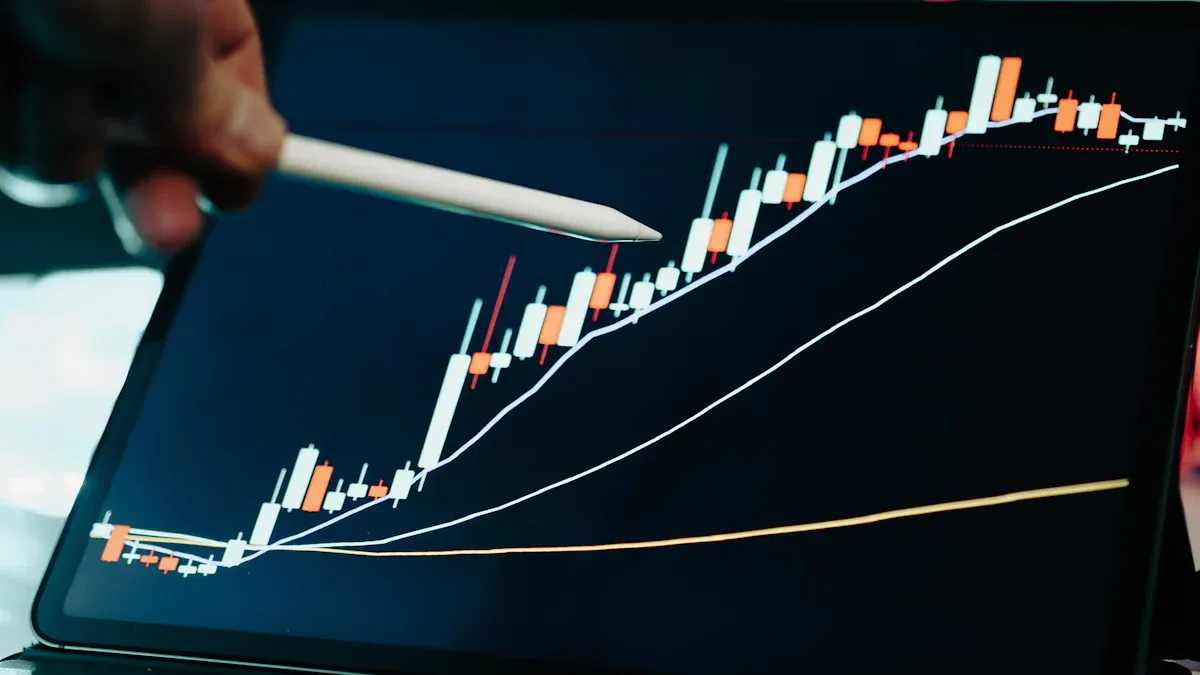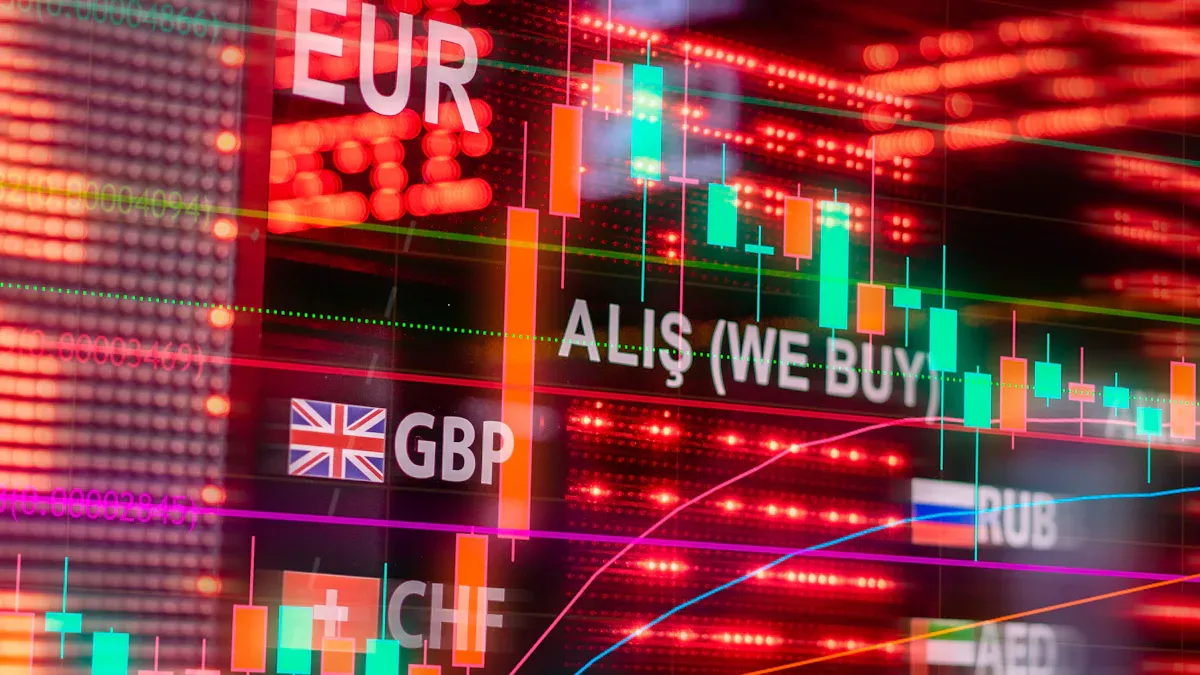- EasyCard
- Trade
- Help
- Announcement
- Academy
- SWIFT Code
- Iban Number
- Referral
- Customer Service
- Blog
- Creator
The Impact and Trends of Exchange Rate Fluctuations: How Does the Global Market Respond?

Image Source: unsplash
Global economic uncertainty is intensifying, and exchange rate fluctuations have become the norm. When markets respond to the impact of exchange rate fluctuations, the core strategy has shifted from speculative betting to proactive management based on the principle of “risk neutrality.” Companies focus on using diversified tools to lock in risks and ensure the stability of their core operations. This raises the core questions that all market participants must face:
- Where are the risks?
- What are the trends?
- How should we respond?
Key Points
- Exchange rate fluctuations have a significant impact on businesses, reducing profits and increasing costs.
- The causes of exchange rate fluctuations are numerous, including national interest rates, market sentiment, and global events.
- Businesses should adjust operations, such as exploring new markets and using different currencies for settlement, to address exchange rate risks.
- Businesses can use financial tools, such as forward contracts and foreign exchange options, to lock in future exchange rates and protect profits.
- Managing exchange rate risks aims to protect a company’s core business, not to profit from exchange rate changes.
Impact of Exchange Rate Fluctuations: Dual Challenges to Profits and Costs

Image Source: pexels
Exchange rate fluctuations pose a direct threat to a company’s financial health. They act like a double-edged sword, simultaneously impacting profits and costs. Research shows that the impact of exchange rate fluctuations has significantly intensified in recent years, affecting corporate sales and profitability about 50% more than previously thought. Businesses must confront this challenge, as it directly relates to their survival and growth.
Profit Erosion: Shrinking Value of Cross-Border Receipts
Export businesses are the most direct recipients of exchange rate risks. When a company settles payments in a foreign currency, any adverse exchange rate movement between signing a contract and receiving payment directly erodes expected profits.
Case Study: A small-to-medium enterprise engaged in cross-border trade issues invoices in the target market’s currency. Due to currency fluctuations during the settlement period, the company lost 6% of its profit on a single order. For industries with already low profit margins, such losses can be devastating.
While a weaker domestic currency theoretically enhances export competitiveness, market responses are often slower than expected. Ultimately, the impact of exchange rate fluctuations manifests more as revenue uncertainty rather than sustained competitive advantage.
Cost Overruns: Budget Exceedances in Import Procurement
For manufacturing businesses reliant on imported raw materials or components, the impact of exchange rate fluctuations is felt on the cost side. Many commodities and critical components are priced in USD, and when the domestic currency depreciates against the dollar, procurement costs rise sharply.
For example, a manufacturing company imports key raw materials from the U.S. If its domestic currency depreciates, purchasing the same quantity of materials requires more local currency, often leading to project budget overruns or even squeezing funds for production activities. This cost pressure driven by a strong dollar is a common inflationary force across many markets.
Asset Risk: Foreign Currency Holdings and Capital Flows
Exchange rate risks are not limited to individual transactions; they also broadly affect a company’s balance sheet. Businesses holding significant foreign currency assets or with overseas subsidiaries face more complex risk exposures. These risks are primarily categorized into three types:
| Risk Type | Definition | Impact |
|---|---|---|
| Transaction Risk | Risks arising from exchange rate changes between the start and settlement of a transaction. | Directly leads to current profit or loss. |
| Translation Risk | Risks from converting overseas subsidiaries’ financial statements due to exchange rate fluctuations. | Affects the consolidated balance sheet’s assets and earnings. |
| Economic Risk | The long-term impact of exchange rate changes on a company’s future cash flows and market competitiveness. | Alters the company’s long-term market value. |
These risks mean that even if a business operates well, exchange rate fluctuations can lead to reduced reported earnings or even impact its valuation in capital markets. Thus, managing the impact of exchange rate fluctuations is a core component of ensuring stable business operations.
Sources of Fluctuations: Key Drivers of Exchange Rate Changes

Image Source: pexels
Understanding the sources of exchange rate fluctuations is a prerequisite for developing effective response strategies. Exchange rates are not random; they result from the interplay of macroeconomic factors, market sentiment, and global events. Business leaders need to understand these drivers to better anticipate risks.
Macroeconomics: Interest Rates and Inflation
Interest rates and inflation are two fundamental macroeconomic variables affecting exchange rates. Central banks manage economies by adjusting interest rates, which directly influence a currency’s attractiveness.
When a country’s central bank (e.g., the U.S.) raises interest rates, its currency typically appreciates. Higher interest rates offer better returns on savings and investments, attracting global capital inflows and increasing demand for that currency. Conversely, lowering interest rates weakens a currency’s value.
In the long term, differences in inflation rates also play a decisive role. Purchasing Power Parity (PPP) theory suggests that countries with higher inflation rates see their currency’s purchasing power decline, leading to long-term depreciation. Conversely, countries with lower inflation rates see their currencies appreciate relatively.
Market Sentiment: Capital Flows and Safe-Haven Demand
In the short term, market sentiment and investor behavior often amplify exchange rate volatility. Historically, many currency crises have stemmed from sudden collapses in market confidence.
- 1997 Asian Financial Crisis: A reversal in market sentiment led to massive capital outflows, causing sharp depreciation of the Thai baht and other Asian currencies.
- 2013 “Taper Tantrum”: The Federal Reserve’s mere hint at reducing its bond-buying program triggered global investor panic, leading to significant capital withdrawal from emerging markets.
During times of heightened global uncertainty, investors seek “safe havens.” The U.S. dollar, due to its asset safety and high liquidity, often serves as a safe-haven currency. When market panic spreads, capital flows into dollar assets, driving USD appreciation and putting significant pressure on other currencies, especially those of emerging markets.
Global Events: Geopolitical and Trade Tensions
Geopolitical conflicts and trade disputes are significant risk sources in modern markets. These events disrupt established economic orders, triggering sharp exchange rate fluctuations. For example, geopolitical events like the Russia-Ukraine conflict and Middle East tensions have led to revaluations of related countries’ currencies and even major global currencies.
Changes in U.S.-China trade relations are particularly illustrative. Since 2018, tariff policies and trade frictions between the two countries have directly impacted the RMB-USD exchange rate. When tensions escalate, uncertainty increases, intensifying exchange rate fluctuations and creating additional operational risks for businesses engaged in U.S.-China trade.
Response Strategies: A Combined Approach from Operations to Financial Tools
Facing pervasive exchange rate risks, businesses can no longer remain passive. Effective response strategies form a multifaceted approach, starting with fundamental operational adjustments, extending through refined internal management, and culminating in precise financial hedging. The goal of this combined strategy is not speculative profit but to build a robust “firewall” for the core business.
Operational Adjustments: Diversifying Markets and Optimizing Terms
The first step in risk management begins at the operational level. Over-reliance on a single market or currency ties a company’s fate to that economy’s fluctuations. Thus, proactive strategic adjustments are critical.
First, businesses can actively explore new markets, particularly seeking growth opportunities outside the USD system. For example, expanding into Southeast Asia, the Middle East, or other non-US markets not only uncovers new revenue streams but also naturally diversifies exchange rate risk exposure.
Second, optimizing trade settlement terms is another effective measure. Traditionally, much of international trade is settled in USD, leaving non-USD zone businesses to bear the full exchange rate risk. Now, more companies are experimenting with non-USD settlements, such as settling directly in the trading partner’s local currency or RMB. This approach offers multiple advantages:
- Strengthening Partnerships: Issuing invoices in the importer’s local currency simplifies their payment process, enhancing customer brand loyalty.
- Accelerating Cash Flow: Non-USD settlements reduce currency conversion intermediaries, speeding up exporters’ receipt of funds.
- Securing Better Rates: Businesses can better control the currency conversion process, avoiding unfavorable “surprise” rates and potentially securing better quotes through local banking relationships.
- Creating Price Advantages: By removing exchange rate risks, importers may receive 1% to 5% price discounts from suppliers, making the company’s products more competitive.
Internal Management: Establishing Dynamic Monitoring and Early Warning Systems
Effective external strategies require robust internal management systems for support. Companies must establish an institutionalized exchange rate risk management process, shifting from reactive “gut-feeling” responses to proactive, systematic management.
A robust internal management system must first address the following core questions:
- How much foreign exchange risk is the company willing to bear?
- What tools can be used to mitigate these risks?
- How can a data-driven, ongoing risk management process be established?
- How can exchange rate risk management be integrated into the company’s long-term strategic planning?
To this end, businesses need to establish dynamic monitoring and early warning systems. This goes beyond daily exchange rate checks, requiring systematic tracking of key indicators affecting exchange rates. Modern risk management leverages technological tools, such as dynamic factor models, integrating global macroeconomic data and high-frequency financial variables like credit default swap (CDS) spreads to identify risk signals earlier.
However, not all companies have the resources or expertise to build complex risk management systems independently. In such cases, seeking advice from external experts is critical. Partnering with professional financial institutions, such as a bank licensed in Hong Kong, can provide tailored support. These institutions can:
- Help companies identify and quantify their unique foreign exchange risk exposures.
- Design and back-test the effectiveness of risk management strategies.
- Provide customized hedging solutions compliant with accounting standards.
- Assist companies in developing risk management strategies for board reporting to secure hedging approvals.
Through such partnerships, businesses can transform institutional expertise into internal management capabilities, avoiding emotional decisions in unfamiliar domains.
Financial Hedging: Using Derivatives to Lock in Risks
When operational adjustments and internal management cannot fully cover risks, financial derivatives become the final line of defense for locking in risks. Tools like forward contracts and foreign exchange options provide “certainty,” helping businesses hedge the erosion of profits due to exchange rate fluctuations.
The primary benefits of using financial tools for hedging are clear:
- Enhanced Forecasting: Locking in future exchange rates enables more accurate cash flow predictions.
- Protecting Core Profits: Minimizing the negative impact of exchange rate fluctuations on operating profits.
- Buying Adjustment Time: When a stronger domestic currency reduces competitiveness, hedging buys time for businesses to adjust marketing and sales strategies.
A classic case is The Walt Disney Company. As early as 1985, to hedge the long-term depreciation risk of its yen-denominated revenue in Japan, Disney adopted an innovative currency swap strategy. By issuing bonds denominated in European Currency Units (ECU), it successfully locked in the yen revenue risk for the next 10 years, saving significant financing costs. This case shows that creative use of financial tools can safeguard long-term operational stability.
Of course, financial hedging is not without costs, and the process can be complex. Therefore, under professional guidance, companies must clearly define the hedging goal as risk reduction and stability, not speculative gains. Only then can financial tools truly become powerful weapons for navigating global market uncertainty.
Practical Toolbox: Analysis of Mainstream Exchange Rate Hedging Tools
Financial tools are precise weapons for managing exchange rate risks. Understanding the mechanics and differences of mainstream tools like forward contracts and foreign exchange options is the foundation for effective hedging strategies.
Forward Contracts: Locking in Future Certainty
Forward contracts are over-the-counter (OTC) tools. They allow businesses to lock in an exchange rate for a future transaction today. The core value of this tool is providing “certainty,” eliminating risks from unfavorable exchange rate movements between agreement and settlement.
Through forward contracts, businesses can more accurately predict future revenues and costs, which is critical for companies reliant on international procurement or sales.
Case Example: A U.S. company A plans to purchase machinery parts worth €1 million from French company B in six months. To avoid cost increases from a euro appreciation against the USD, Company A signs a forward contract with a bank, locking in an exchange rate of 1 EUR = 1.08 USD.
- Scenario 1: Six months later, the market rate becomes 1 EUR = 1.12 USD. Company A can still buy euros at the locked-in rate of 1.08, saving $40,000.
- Scenario 2: If the market rate drops to 1 EUR = 1.05 USD, Company A must still execute at the contracted rate of 1.08. While this may seem like a “loss,” it achieves the original goal: cost certainty.
Foreign Exchange Options: Retaining Flexibility
Unlike forward contracts, foreign exchange options provide a “right” rather than an “obligation”. After paying a premium, the purchasing company has the right, but not the obligation, to buy or sell foreign currency at an agreed price in the future. This flexibility is its greatest advantage.
- Protecting Downside Risk: If exchange rates move unfavorably, the company can exercise the option to lock in the worst-case scenario.
- Capturing Upside Gains: If exchange rates move favorably, the company can forgo the option and transact at the better market rate, gaining additional profits.
For example, Boeing expects to receive a GBP payment and is concerned about GBP depreciation. It purchases a put option, locking in a minimum selling price of 1 GBP = 1.46 USD. If the market rate drops to 1.30 USD, Boeing exercises the option; if it rises to 1.60 USD, it forgoes the option and sells at the higher market rate. The option allows Boeing to mitigate risk while retaining profit potential.
Common Misconceptions: Why Hedging Can Appear to “Lose Money”
Financial statements sometimes show hedging transactions as “losses,” which often confuses managers. This primarily stems from two reasons:
- Opportunity Cost: When the market moves favorably, a locked-in forward contract rate may be less advantageous than the current market rate. This “loss” is actually the opportunity cost of forgoing potentially higher profits to achieve “certainty.” For businesses, ensuring profit stability is often more valuable than chasing uncertain exchange rate gains.
- Accounting Treatment: Accounting standards require financial instruments to be valued at fair value, and their value changes may differ in timing or method from the hedged business (e.g., accounts receivable). This technical mismatch can result in temporary losses on paper, even if the hedging strategy is economically successful.
Thus, businesses should correctly view hedging “losses,” understanding that the goal is to eliminate uncertainty, not to pursue speculative profits.
In the context of exchange rate fluctuations becoming the norm, a single strategy is insufficient to address complex challenges. Businesses must adopt a combined approach of “operational adjustments, internal monitoring, and financial tools” to safeguard operational certainty.
The cornerstone of all strategies is establishing a “risk-neutral” mindset. The goal is to protect core business profits, not to speculate for gains.
Business owners and financial managers should actively practice exchange rate risk management, turning uncertainty into a core competitive advantage.
FAQ
Why is the goal of hedging risk neutrality rather than profit?
Exchange rate speculation carries extremely high risks and can lead to significant losses. The core goal of hedging is to eliminate uncertainty and protect the stability of core business profits. Companies should focus on their primary operations rather than taking risks in unfamiliar financial markets.
Do small and medium enterprises (SMEs) also need to hedge exchange rates?
Yes. SMEs can also use exchange rate risk management tools. Many financial institutions offer simplified forward contracts and options tailored for SMEs. Proactive risk management is critical for businesses of any size engaged in cross-border operations to protect profits effectively.
Are the costs of exchange rate hedging high?
Hedging costs mainly consist of two parts: the bid-ask spread in forward contracts and the premium paid for foreign exchange options. Businesses should view these costs as “insurance fees” for ensuring profit stability, not as transaction losses.
How often should exchange rate risk management strategies be evaluated?
Exchange rate risk management strategies are not static. Companies should review them at least quarterly or when significant market changes occur. Regular evaluations ensure that hedging strategies remain aligned with business goals and market conditions for optimal results.
*This article is provided for general information purposes and does not constitute legal, tax or other professional advice from BiyaPay or its subsidiaries and its affiliates, and it is not intended as a substitute for obtaining advice from a financial advisor or any other professional.
We make no representations, warranties or warranties, express or implied, as to the accuracy, completeness or timeliness of the contents of this publication.




Contact Us
Company and Team
BiyaPay Products
Customer Services
is a broker-dealer registered with the U.S. Securities and Exchange Commission (SEC) (No.: 802-127417), member of the Financial Industry Regulatory Authority (FINRA) (CRD: 325027), member of the Securities Investor Protection Corporation (SIPC), and regulated by FINRA and SEC.
registered with the US Financial Crimes Enforcement Network (FinCEN), as a Money Services Business (MSB), registration number: 31000218637349, and regulated by FinCEN.
registered as Financial Service Provider (FSP number: FSP1007221) in New Zealand, and is a member of the Financial Dispute Resolution Scheme, a New Zealand independent dispute resolution service provider.




















